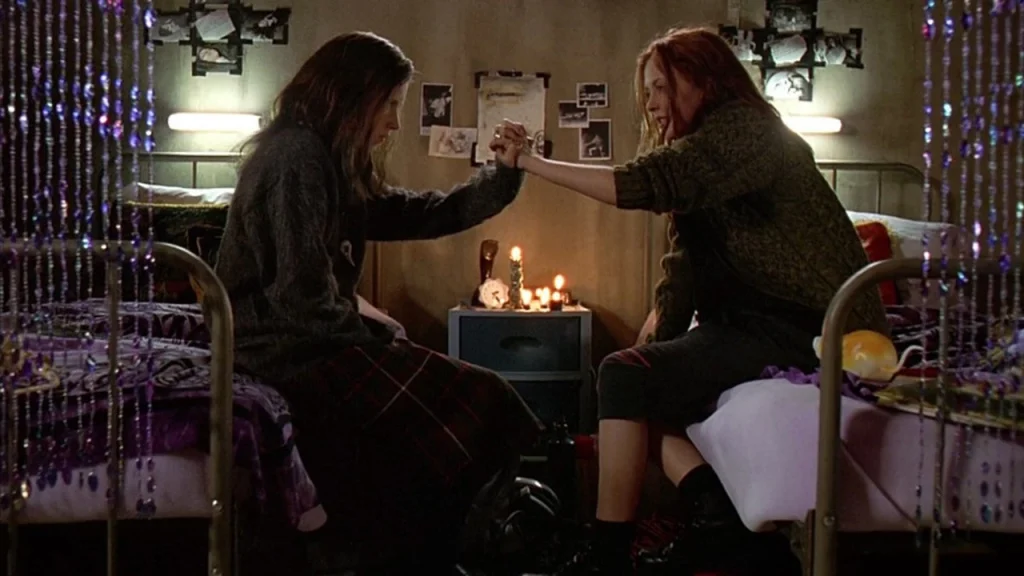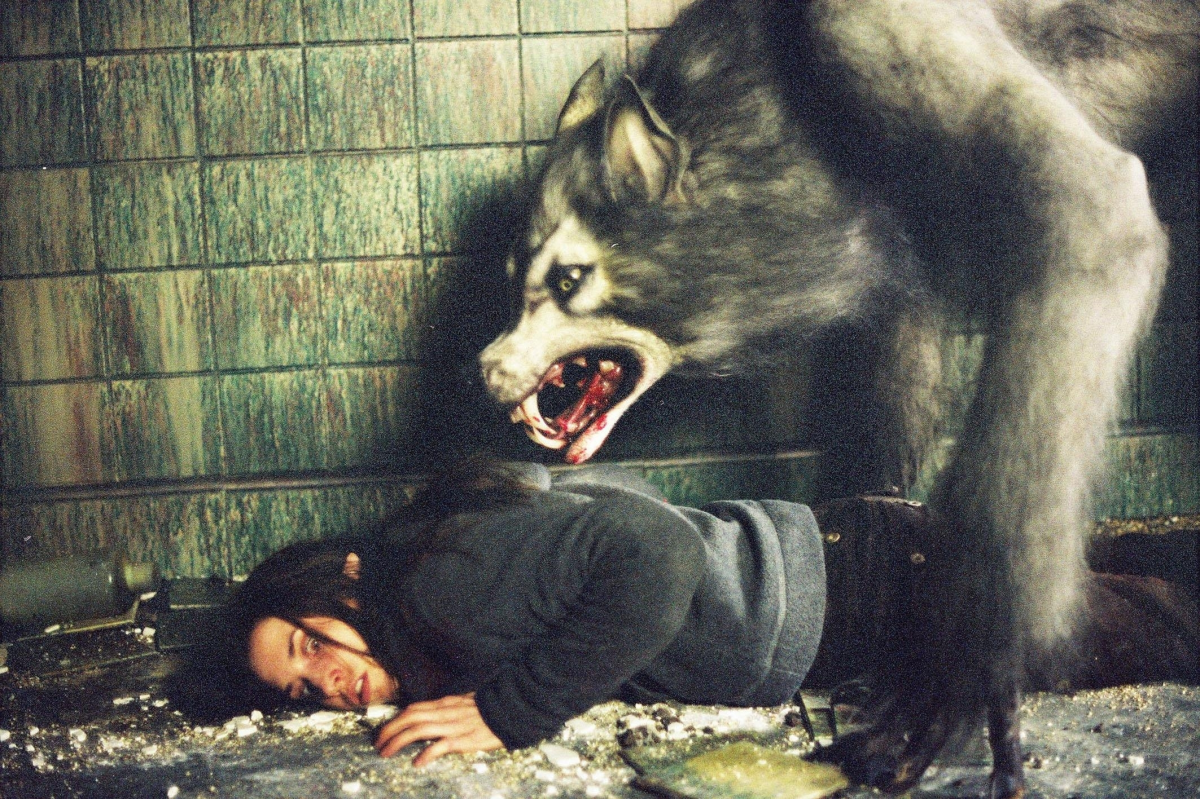
“B, I Just Got The Curse”

In his direction of the initial werewolf attack in Ginger Snaps (2000), John Fawcett repeatedly frames close shots of the creature’s bloodied snout and teeth as it savages the central character, Ginger. These close shots lead to what I argue is a reinterpretation of the lycanthrope, wherein the werewolf is detached from traditional folktales of masculine criminality(1) and – as I shall go on to emphasise through a psychoanalytic framework – is merged with symbolic images of the vagina and menstruation to foreground a narrative re-gendering of the werewolf. Central to my understanding of this is Barbara Creed’s writing on the vagina dentata, the toothed vagina, in the horror film genre. Creed’s discerning of these images rests on her emphasis that “all images of menacing, toothed mouths – regardless of the gender of the character – suggest the vagina dentata”(2). Expanding on this further, Creed determines that “some myths represent the toothed vagina as an animal or an animal companion to the female”(3). Due to this, I argue that Fawcett’s werewolf represents a mythical embodiment of the vagina dentata in the first instance that, in attacking Ginger in this scene and infecting her, ‘passes on’ the capabilities of the female castrator. Intrinsic to understanding this within the scene is Fawcett’s combining of the scene’s visual focal point, the mouth, and the scene’s narrative focal point, the menstruating teenage girl.
It is important to note that the nature of psychoanalytic studies rests on ideologies aligned with that of the human animal rather than that of the non-human animal. In her essay, ‘Becoming woman’/Becoming Wolf: Girl Power and the Monstrous Feminine in the Ginger Snaps Trilogy’, Batia Boe Stolar draws upon Delueze and Guatarri to emphasise that psychoanalysis lacks a “truly zoological vision”(4). For Delueze and Guatarri, psychoanalysis determines an individualism that lacks consideration of the importance of a “pack, a band, a population, a peopling, in short, a multiplicity”(5) to animality. Ginger and Bridgette’s kinship as sisters is important Fawcett’s plot and offers an example into understanding this scene’s narrative focal point. The menstrual cycle divides Ginger and Bridgette’s “pack”, signifying a shift from youthful freewill to the “bourgeois ideology of suburbia”(6). In this sense, the individual becomes important, lending the scene to a psychoanalytic study. As Fawcett focuses on foregrounding the start of Ginger’s transformation, both as a lycanthrope and as a menstruating woman, it is Ginger’s own experience of embodying both animality and menstruation that is important within the film’s entirety.

In understanding this, the scene’s visual focal point of the werewolf’s mouth unfolds into a depiction of feminine monstrosity. The action is foregrounded by a medium shot of Ginger on top of Bridgette as she attempts to flee the werewolf. As Ginger is dragged away from her sister, the shot is then mirrored by another medium shot of the werewolf mounting Ginger in a similar manner. In coupling these frames, Fawcett emphasises how the scene’s interest has moved beyond that of the initial sisterly “pack” to that of Ginger’s transformation, as the werewolf’s primal attraction to Ginger is understood to be the scent of her menstrual blood. Due to this, Fawcett creates an on-screen hierarchy of dominance, wherein the composition of the werewolf and Ginger champions the transformative ideas of the menarche and the theanthropic in opposition to that of the initial importance of Ginger and Bridgette’s familial connection. In these frames, the camera is constantly dynamic as it moves rapidly between capturing the action of all three characters throughout the scene’s initial struggle.


Contrastingly, in action that focuses on the werewolf wounding Ginger by clawing her flesh and biting through her clothes, Fawcett allows the camera to linger. As pictured in the GIF below, Fawcett elongates the length of this close shot depicting the werewolf’s wet and bloodied snout. Accompanying this, Fawcett’s camera shakes as it imitates the movement of the werewolf’s bite. The scene’s diegetic sound is overwhelmed by the syncing of Bridgette and Ginger’s pained screams, juxtaposed by the growls of the werewolf. Isabel Pinedo describes the “wet death” in horror, wherein a stylized depiction of gore such as that portrayed in this scene by Fawcett “transgresses bodily boundaries by devouring, penetrating or spilling the contents of the body through carnage. It shows the destruction wrought upon the human body so as to transform it into a monstrous spectacle” (7). Within this, ideas of cinematic identification are important. By allowing the camera to focus entirely on the creature and its mouth, Fawcett aligns his audience with the animal. He emphasises the danger of the bite and its capabilities of passing on the werewolf gene in an act of transformation and “monstrous spectacle”. Like the vagina dentata, the werewolf’s mouth becomes a vessel for both mutation and birthing wherein Ginger’s later rebirth as a werewolf is founded through violence and bodily harm.

While Fawcett’s camera work upholds many of the understood truths of lycanthrope folktale, the creative subjectivity of his own werewolf narrative allows him to add a reinterpretation to this history. In aligning Fawcett’s vision of the lycanthrope as an image of devouring femininity with the works of feminist horror critics such as Barbara Creed, Ginger Snaps’ depictions of bodily pain, as caused by linking the menarche with the lycanthrope and evoking the vagina dentata, determines the werewolf’s mouth as the central feminine weapon of attack.


Bibliography:
(1) Evans, Tania, ‘Full Moon Masculinities: Masculine Werewolves, Emotional Repression, and Violence in Young Adult Paranormal Romance Fiction, Gothic Studies, 21.1 (2019) 28-39 <https://www.deepdyve.com/lp/edinburgh-university-press/full-moon-masculinities-masculine-werewolves-emotional-repression-and-bAxTAH5w0r>
(2) Creed, Barbara, The Monstrous-Feminine: Film, Feminism, Psychoanalysis (London: Routledge, 1993)
(3) Creed, Barbara, The Monstrous-Feminine: Film, Feminism, Psychoanalysis (London: Routledge, 1993)
(4) Stolar, Batia Boe, ‘Becoming woman’/Becoming Wolf: Girl Power and the Monstrous Feminine in the Ginger Snaps Trilogy’ in Werewolves, Wolves and the Gothic, ed. by Robert Mckay and John Miller, (Cardiff: University of Wales Press, 2017) pp. 85-99
(5) Stolar, Batia Boe, ‘Becoming woman’/Becoming Wolf: Girl Power and the Monstrous Feminine in the Ginger Snaps Trilogy’ in Werewolves, Wolves and the Gothic, ed. by Robert Mckay and John Miller, (Cardiff: University of Wales Press, 2017) pp. 85-99
(6) Stolar, Batia Boe, ‘Becoming woman’/Becoming Wolf: Girl Power and the Monstrous Feminine in the Ginger Snaps Trilogy’ in Werewolves, Wolves and the Gothic, ed. by Robert Mckay and John Miller, (Cardiff: University of Wales Press, 2017) pp. 85-99
(7) Stopenski, Carina, ‘Exploring Mutilation: Women, Affect, and the Body Horror Genre’ Literature and Culture, 2.12 (2022) DOI: 10.15291/sic/2.12.lc.1
